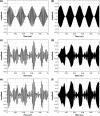Effects of spectral smearing of stimuli on the performance of auditory steady-state response-based brain-computer interface
- PMID: 29147144
- PMCID: PMC5670086
- DOI: 10.1007/s11571-017-9448-y
Effects of spectral smearing of stimuli on the performance of auditory steady-state response-based brain-computer interface
Abstract
There have been few reports that investigated the effects of the degree and pattern of a spectral smearing of stimuli due to deteriorated hearing ability on the performance of auditory brain-computer interface (BCI) systems. In this study, we assumed that such spectral smearing of stimuli may affect the performance of an auditory steady-state response (ASSR)-based BCI system and performed subjective experiments using 10 normal-hearing subjects to verify this assumption. We constructed smearing-reflected stimuli using an 8-channel vocoder with moderate and severe hearing loss setups and, using these stimuli, performed subjective concentration tests with three symmetric and six asymmetric smearing patterns while recording electroencephalogram signals. Then, 56 ratio features were calculated from the recorded signals, and the accuracies of the BCI selections were calculated and compared. Experimental results demonstrated that (1) applying smearing-reflected stimuli decreases the performance of an ASSR-based auditory BCI system, and (2) such negative effects can be reduced by adjusting the feature settings of the BCI algorithm on the basis of results acquired a posteriori. These results imply that by fine-tuning the feature settings of the BCI algorithm according to the degree and pattern of hearing ability deterioration of the recipient, the clinical benefits of a BCI system can be improved.
Keywords: Brain–computer interface; Hearing impairment; Spectral smearing; Subjective experiment.
Figures






Similar articles
-
Effects of degree and symmetricity of bilateral spectral smearing, carrier frequency, and subject sex on amplitude of evoked auditory steady-state response signal.Cogn Neurodyn. 2019 Apr;13(2):151-160. doi: 10.1007/s11571-018-9512-2. Epub 2018 Nov 13. Cogn Neurodyn. 2019. PMID: 30956719 Free PMC article.
-
Effects of spectral smearing and temporal fine structure degradation on speech masking release.J Acoust Soc Am. 2009 Jun;125(6):4023-33. doi: 10.1121/1.3126344. J Acoust Soc Am. 2009. PMID: 19507983
-
A novel hybrid auditory BCI paradigm combining ASSR and P300.J Neurosci Methods. 2017 Mar 1;279:44-51. doi: 10.1016/j.jneumeth.2017.01.011. Epub 2017 Jan 18. J Neurosci Methods. 2017. PMID: 28109832
-
Brain-computer interfaces using capacitive measurement of visual or auditory steady-state responses.J Neural Eng. 2013 Apr;10(2):024001. doi: 10.1088/1741-2560/10/2/024001. Epub 2013 Feb 28. J Neural Eng. 2013. PMID: 23448913
-
Auditory steady-state responses.J Am Acad Audiol. 2012 Mar;23(3):146-70. doi: 10.3766/jaaa.23.3.3. J Am Acad Audiol. 2012. PMID: 22436114 Review.
Cited by
-
Filter bank temporally local canonical correlation analysis for short time window SSVEPs classification.Cogn Neurodyn. 2020 Oct;14(5):689-696. doi: 10.1007/s11571-020-09620-7. Epub 2020 Jul 29. Cogn Neurodyn. 2020. PMID: 33014181 Free PMC article.
-
Mental fatigue level detection based on event related and visual evoked potentials features fusion in virtual indoor environment.Cogn Neurodyn. 2019 Jun;13(3):271-285. doi: 10.1007/s11571-019-09523-2. Epub 2019 Jan 29. Cogn Neurodyn. 2019. PMID: 31168331 Free PMC article.
-
Novel hybrid brain-computer interface system based on motor imagery and P300.Cogn Neurodyn. 2020 Apr;14(2):253-265. doi: 10.1007/s11571-019-09560-x. Epub 2019 Oct 21. Cogn Neurodyn. 2020. PMID: 32226566 Free PMC article.
-
Effects of degree and symmetricity of bilateral spectral smearing, carrier frequency, and subject sex on amplitude of evoked auditory steady-state response signal.Cogn Neurodyn. 2019 Apr;13(2):151-160. doi: 10.1007/s11571-018-9512-2. Epub 2018 Nov 13. Cogn Neurodyn. 2019. PMID: 30956719 Free PMC article.
References
-
- Duszyk A, Bierzyńska M, Radzikowska Z, Milanowski P, Kuś R, Suffczyński P, Michalska M, Łabęcki M, Zwoliński P, Durka P. Towards an optimization of stimulus parameters for brain–computer interfaces based on steady state visual evoked potentials. PLoS ONE. 2014;9(11):e112099. doi: 10.1371/journal.pone.0112099. - DOI - PMC - PubMed
LinkOut - more resources
Full Text Sources
Other Literature Sources
Molecular Biology Databases

